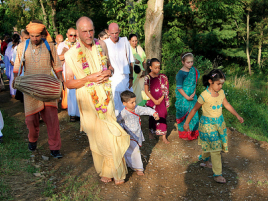Swami Recreates Indian Holy Places in West Virginia
By Madhava Smullen | Aug 07, 2010

Varshana Swami, a long-time resident of New Vrindaban in West Virginia, welcomed devotees this July 25th to see his progress in recreating the holy places of the original Vrindaban at the ISKCON community’s rural property.
This, in fact, was one of ISKCON Founder Srila Prabhupada’s primary mandates for the community when it was first established in the 1960s—the second being to live in harmony with nature. “I understand the spot [New Vrindaban] is very beautiful, and the hills may be renamed as New Govardhana,” he wrote to Hayagriva Dasa in a 1968 letter. “If there are lakes, they can be renamed as Shyama Kunda and Radha Kunda.”
Between 1972 and 1988, Varshana Swami spent most of his time in dedication to the second mandate, utilizing his experience in animal power and natural resources to farm the land.
In 1979, since there were no lakes at New Vrindaban, he also “excavated” ponds that would replicate the sacred lakes Radha Kunda and Shyama Kunda in Krishna’s birthplace of Vrindaban, India.
By the year 2000, Varshana Swami had begun to focus predominantly on Prabhupada’s first mandate—recreating holy places—and purchased the section of land at New Vrindaban that contained the lakes.
“It’s very geographically similar to the original Vrindaban,” he says. “What we call ‘the swan-boat lake,’ on which the Deities of Radha-Vrindaban-Chandra are taken out for a ride, looks like a very rustic rendition of Kushum Sarovara. And just as in the original Vrindaban, it lies at the foot of Govardhana Hill, which is here represented by a large ridge. Past this are the twin sacred lakes Radha Kunda and Shyama Kunda.”
Since 2000, Varshana Swami has been living and working on the land—right across the road from the famous Prabhupada’s Palace—and developing it according to his vision.
Recently, he began to pray for help with the project he’d tackled alone for years. Sure enough, help came—but not in exactly the form he’d imagined. Instead of direct human labor, devotees sponsored dioramas of the 16th Century Vaishnava saints known as the Six Goswamis of Vrindavana.
“Looking at it according to our tradition, it was actually very appropriate that it was the Six Goswamis who came to help in excavating the holy places,” says Varshana Swami. “And that’s not just philosophical—with their arrival, devotees’ interest in the project has increased.”
The fiberglass dioramas of Rupa, Sanatan, Raghunatha Bhatta, Jiva, Gopal Bhatta, and Raghunatha Dasa Goswamis were created by Milan, a Bengal-based sculptor whom Srila Prabhupada knew and praised.
In an official ceremony on Sunday July 25th—the holy day of Guru Purnima and the disappearance day of Sanatana Goswami—the colorful two-foot dioramas were welcomed to New Vrindaban, along with 8-inch forms of the Asta-Sakhi gopis, who are eternal servants of Radha and Krishna in the spiritual world.
They were joined by Radha-Gopinatha, Deities who have been resident in a cabin known as Radha-Gopinath Mandir on the banks of Radha Kunda and Shyama Kunda since 2000. Also revealed on the day was a three-foot diorama of Vrinda Devi, a leading gopi who assists in Radha-Krishna’s pastimes, and Vishva Mahadeva, better known as Lord Shiva.
Forty to fifty devotees, mostly local, attended the event from 5pm on into the evening. After bathing Radha-Gopinath in a sacred ceremony known as abhisekha, Varshana Swami gave a tour of the pilgrimage site, explaining the relationship between the different Deities present.
“Although the term ‘Six Goswamis’ is widely used, there were in fact eight goswamis who were contemporaries, including Lokanatha Dasa and Krishna Dasa Kaviraja,” he says. “The theological perspective of the relationship between the eight goswamis, the Asta-Sakhis, and Radha-Krishna is compared to a lotus: Radha and Krishna are the whorl, the Asta-Sakhis are the petals, and eight more confidential gopi servants called the Asta-Manjaris—who are the eternal forms of the eight goswamis—are the stem.”
Because of the Manjaris’ close proximity to Radha-Krishna, as well as their eternal youthful innocence and emotional intensity, Vaishnava tradition describes them as having the deepest understanding of the nature of Radha-Krishna.
“Therefore,” Varshana Swami explains, “The eight goswamis are the most appropriate emissaries of Lord Chaitanya’s mission, able to present it in a way that is beneficial to this world’s present and future generations. And this also makes them the essential foundation of ISKCON and our spiritual progress.”
Next, Varshana Swami will continue to develop his project into a larger vision. Work on an Asta-Sakhi Mandir—a simple yet beautiful gazebo-style octagon—began two weeks ago. And the temple, a sister to the already existing Radha-Gopinath Mandir, will be opened this September 15th in honor of Srimati Radharani’s Appearance Day.
The recreated holy places will become a major part of festivals related to Govardhana Hill, Radha-Kunda and Shyama Kunda, the Six Goswamis, and the Asta-Sakhis, as well as being another spiritual attaction for New Vrindaban pilgrims.
But the project will also incorporate Prabhupada’s other primary mandate for New Vrindaban— living in harmony with nature.
“Since we welcomed the Six Goswamis, devotees have consistently given me feedback that this is just like the original Vrindaban, because of its rural quality and simplicity,” says Varshana Swami. “So I’ve felt inspired to incorporate my previous service of natural resources and animal power. Already, we have a team of oxen, and I’m developing a garden. We also have a conservancy of five-year-old fruit and nut trees such as Chinese chestnut, persimmon, apple, sugar maple, and paw-paw.”
Varshana Swami would like to expand these efforts to bring New Vrindaban back to its previous high level of natural living.
“And with the presence of Vrinda Devi, who orchestrates the natural world for Radha and Krishna’s pastimes,”he concludes, “I feel certain that the project will be blessed.”















